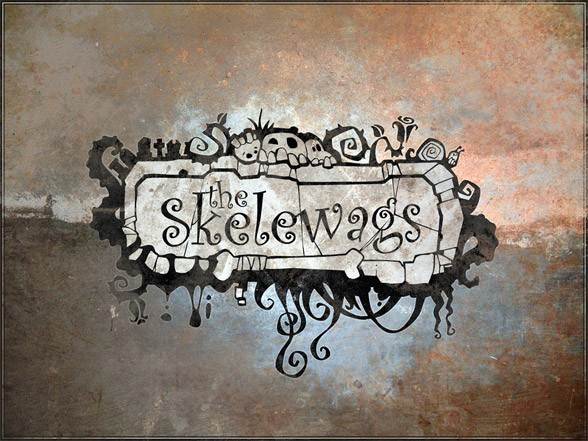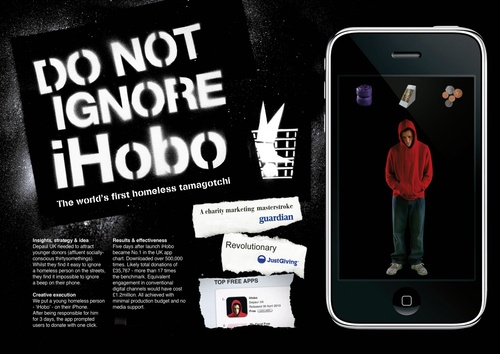-
Another street art artist I've just discovered. Really talented. I love his little skeleton characters!
 5 comments
5 comments
-
Keep Calm and Carry On was a poster produced by the British government in 1939 during the beginning of the Second World War, intended to raise the morale of the British public in the event of invasion. It was little known and never used. The poster was rediscovered in 2000 and has been re-issued by a number of private sector companies, and used as the decorative theme for a range of other products. There are only two known surviving examples of the poster outside of government archives
Blogged from Wikipedia.
Stéphanie Cialone sent me the following documents that are really bloggstorming.
It is really interesting to study the text which shows that the posters originally designed to motivate the English people against invasions during WWII are to be seen everywhere in England nowadays.
Moreover, the actional project could be to imagine a parody of the famous posters. You can find examples at the end of the post.
Thanks a lot Stéphanie for the documents!!

Keep calm and put up your poster
All around the nation, nostalgia lovers are keeping faith with a slogan to get through the hard times ahead. The Keep Calm And Carry On poster was designed to help boost morale in the second world war, and it has been rediscovered to become the logo of the credit crunch...
Adapted from guardian.co.uk,
Wednesday 18 March 2009
“An original version that has seen better days” - Photograph: Mike Coop



ARTIST STATEMENT
Inspired by reading Keep Calm and Carry On: Jon Henley on the poster we just can't stop buying in The Guardian one lunchtime, and being in a bit of a mood.
Get Excited And Make Things
by Matt Joneshttp://www.20x200.com/art/2009/04/get-excited-and-make-things.html
Text dealing with the subject:
What crisis?
It's the pin-up of our age, gracing homes, shops - even a US embassy. Jon Henley on the poster we just can't stop buying
01
05
10
15
20
25
30
35
Nowadays, of course, it would be farmed out to an expensive communications agency. Back in the spring of 1939, it was an anonymous civil servant who was entrusted with finding the slogan for a propaganda poster intended to comfort and inspire the populace should, heaven forbid, the massed armies of Nazi Germany ever cross the Channel.
This was the third in a series. The first, designed to stiffen public resolve ahead of likely gas attacks and bombing raids, was printed in a run of more than a million and read: Your Courage, Your Cheerfulness, Your Resolution Will Bring Us Victory. The second, identically styled, stated: Freedom Is In Peril.
From August 1939, both posters began appearing all over the country, on billboards, in shops, on railway platforms. The third, though, was held back. This one was for the real crisis: invasion. A few may have made their way on to select officials' walls, but the vast majority of the British public never got to see it. This poster enjoined: Keep Calm And Carry On.
And suddenly these days, it's everywhere, from homes to pubs to government offices. The Lord Chamberlain's Office at Buckingham Palace, the prime minister's strategy unit at No 10, the Serious Fraud Office, the US embassy in Belgium, the vice chancellor of Cambridge University, […] have all ordered posters. Even David Beckham has the T-shirt, we are told.
For 60 years, the poster had been forgotten. Then, one day in 2000, Stuart Manley, co-owner with his wife Mary of Barter Books in Alnwick, Northumberland, was sifting through a box of hardbacks he had bought at auction when he saw "A big piece of paper folded up at the bottom. I opened it out, and I thought, wow. That's quite something. I showed it to Mary, and she agreed. So we framed it and put it up on the bookshop wall. And that's where it all started."
Today, you can buy Keep Calm and Carry On mugs, doormats, T-shirts, hoodies, cufflinks, baby clothes and flight bags from any number of retailers. You can use the design as a screensaver for your computer or mobile phone. There are even spoofs. Facsimiles of the poster itself, which Barter Books initially reproduced after a rash of customers asked to buy its copy (one offered £1,000), have sold in their tens of thousands.
Manley has sold some 41,000 posters. He is not the only one. Mike Coop of keepcalmandcarryon.com reckons he is shifting 300-500 products a week (and admits to having tried to trademark the phrase); the Keep Calm Gallery's Lucas Lepola is selling "probably around 500 a month". […] The reasons, experts reckon, are manifold.
Alain Samson, a social psychologist at the London School of Economics, says that in times of difficulty, "people are brought together by looking for common values or purposes, symbolised by the crown and the message of resilience. The words are also particularly positive, reassuring, in a period of uncertainty, anxiety, even perhaps of cynicism."
Dr Lesley Prince, who lectures in social psychology at Birmingham University, is blunter still. "It is a quiet, calm, authoritative, no-bullshit voice of reason," he says. "It's not about British stiff upper lip, really. The point is that people have been sold a lie since the 1970s. They were promised the earth and now they're worried about everything - their jobs, their homes, their bank, their money, their pension. This is saying, look, somebody out there knows what's going on, and it'll be all right".
Adapted from Jon Henley’s article in The Guardian, Wednesday 18 March 2009
Tool boxSift through (18) = sort = examine minutelyResilience (33) = ability to recover readily from illness, depression, adversity, or the likeKeep a stiff upper lip (36) = keep your chin up = to face misfortune bravely and resolutely / to suppress the display of any emotion.Parodies:



 your comment
your comment
-

I don't know you but I'm more and more stricken by the growing number of young people living in the streets with their dogs. Usually, I avoid looking at them. I'm not proud of it.
I watched a documentary about the phenomenon and was really affected by it. I'd like to deal with the subject in class and I found some interesting documents. I just share them with you.

The aim would be to make pupils aware of the reasons why young people "have" to live in the street. Then they would have to propose solutions (actional project) to fight against Youth Homelessness.

Videos:
Here are some facts (Causes and consequences):
A document from the National Coalition for the Homeless (NCH)
A document from Youthnoise:
(Blogged from: www.youthnoise.com)
Youth Homelessness: Facts and Solutions
- Facts
- Characteristics of Homeless Youth
- Pathways out of Homelessness
- Causes of Youth Homelessness
- Four Basic Types of Homeless Youth (Meet the Youth)
- Effective Solutions for Youth Homelessness
- 10 Needs to Prevent and End Youth Homelessness
- What Needs to Change?
Facts
If you don't personally know someone living on the streets, it's easy to pretend youth homelessness isn't a problem. It is a problem, and it affects millions of normal kids every day. It's time to wake up and pay attention.
- 1.6 to 1.7 million people under 18 will experience homelessness each year. (That's more than the population of Philadelphia.)
- The National Coalition for the Homeless defines homeless youth as individuals under the age of eighteen who lack parental, foster, or institutional care.
- 1 out of every 3 homeless people are under the age of 18.
- Approximately half of all runaways were physically abused before fleeing home.
- The majority of homeless and runaway youth are between the ages of 15 and 17, however three out of 100 runaways are under the age of 10, and 11 out of 100 are between the ages of 11 and 13.
- Approximately half of all runaways were physically abused before fleeing home.
- A third of all runaways will attempt suicide.
- Homeless youth are up to ten times more likely to have or contract HIV than non-homeless adolescents.
- A tenth of homeless and runaway females are reportedly pregnant.
- This year, one in 260 runaways and homeless youths will die from assault, illness and suicide.
Characteristics of Homeless Youth
- No self-sufficiency skills
- No financial resourcesv
- Mental health problems; post-traumatic stress disorder
- Deteriorating physical health
- Substance Abuse
Pathways of Homelessness
The three most common pathways are:
- Parents
- Extended family
- Independent living (only after trying the other two)
Causes of Youth Homelessness
- Family breakdown: a result of dysfunctional or troubled situation
- Systems failure: mainstream programs like child welfare, juvenile corrections facilities and mental health programs. Former foster care youths are disproportionately represented in the homeless population.
Meet the Youth
There are four basic types of homeless youth.
- Fleeing/Runaway, Jamie.
- Episodic (a.k.a. Couch Surfers), Eva.
- Street-Dependent (Travelers/Squatters),Ryan
- Unaccompanied (Shelter Hoppers), Karina.
Solutions
There are three main different kinds of effective solutions:
- Early Intervention/Prevention: make sure a homelessness episode or a family separation doesn't result in long-term homelessness.
- Improve mental health and family systems.
- Intervene with Already-Homeless Youth: to reunite them quickly with their families while strengthening the families' stability
- Independent Housing Options: to help youth who will not be able to return to their families.
Some youth will never be able to return to their families; they need housing programs that provide both shelter and support to help them become self-sufficient...but each type of homeless youth has different needs:
- Jamie (Runaway) and Eva (Episodic) would benefit from early intervention, mental counseling, community-based services, and alternative family placements.
- Karina (Shelter Hopper) requires intensive family reunification services, case managers, or youth advocates or life skills training.
- Ryan (Street-Dependent) would be helped from street-based outreach and one-on-one connections; it's important for housing to provided first before tackling other issues.
10 Needs to Prevent: End Youth Homelessness
- Plan: strategies focused on ending youth homelessness
- Data: how many youth are homeless, what their needs are, etc.
- Emergency prevention: crisis counseling, family reunification services, etc.
- Systems prevention: mainstream programs that provide care and services to youth
- Outreach: programs that reduce barriers and encourage homeless youth to enter the system
- Youth housing continuum: youth shelters, transitional housing, etc.
- Services: access to funded services through mainstream programs
- Youth development: programs that engage youth in meaningful ways, building leadership and decision-making skills
- Permanent housing: supportive housing for homeless youth
- Income: assistance to homeless youth to secure income; educational and vocational programs
What Needs to Change?
Most cities focus on "reaction" solutions instead of long-term solutions. Some good interventions that are not being developed or supported enough are:
- Peer Outreach: train young people (ages 16 to 21) to go out on the street with adult outreach workers. (Homeless youth trust other youth much more easily than they trust adults.)
- Crisis Assistance Information to Youth: develop community-based outreach where young people are (like schools) to prevent homelessness.
- Better Inter-Organization Coordination: create local resource centers and/or websites that address the varied needs of at-risk youth
- Affordable Housing: increase the number of affordable housing options for young adults (ages 16 to 25).
Youth homelessness is a large problem, but by no means is it a hopeless one. If we try to understand the problem as a whole, we can begin to work toward better solutions.
Here is an interesting campaign launched to sensitize people:
More information: http://lemonsblack.com/do-not-ignore-ihobo/
Here is the description of the application you can download on Itunes:
Description
Meet the young homeless person who will be living on your iPhone for the next three days.
You’ll need to be there for him, day and night, providing food, money, warmth and support. He’ll alert you when he gets into trouble or needs your help. And the speed of your response could be the difference between him making it through in one piece, or becoming addicted to drugs.
Depaul UK is the largest youth homeless charity in the UK. For more information go to www.depauluk.org 4 comments
4 comments
-
Nick Print is an artist who created the following painting. It is supposed to gather all that could symbolize London.
Possible Xblogtation: Do the same with another city, film or novel...
 5 comments
5 comments
-
A very interesting concept. Make the logos tell what they really are and emphasize their dark aspects. A funny criticism of the companies.
Possible Xblogtation: Are you up to do your own logo?
Blogged from designerscouch.org
 8 comments
8 comments
-
Lucy Knisley is a very gifted cartoonist. She designed the following summaries of Harry Potter episodes. Some elements of the stories are missing but the cartoons are great and fun!
Here is Lucy's blog: http://lucylou.livejournal.com/
Possible Xblogtation: The cartoons can become trigger documents for oral or written productions. Pupils could create their own to sum-up a short story for example.
 12 comments
12 comments
-
Here is the link to the school's website:
http://www.lycee-einstein.fr/site/
English teachers (2011):
Frédéric CADILHAC

 8 comments
8 comments
-
Dorothy's dolls.
> This matriochka doll is about the grandmother Dorothy, that's why I chose a smily old woman at first.
> Then, we can see Tinker Bell. I think that Dorothy is like her because it's like she's got a "magical power", when she's here, everything is ok.With the pixie, it's the same
thing, with her wand, she changes all bad situations.The link between the two is that everything became beautiful with them.
> Next, there is Mary Poppins.Poppins is a famous nanny. Her and Dorothy are close because they're human and especially they take care of children and all the house. The
Banks' familly needs Mary's help and because of her, parents will understand that their dream dislocates all the familly.It's the same for the Lovatts. Harriet and David want to
have a big familly but the old woman says to them that it's crazy and they realize it at the end.
> Last, I put Super nanny. She controls every thing, she changes parents and children, she's got a strong personnality and imposes her rules. We can say that Dorothy is
the same basically. Also, she's self-asured and is not afraid about nothing.All the familly loves this incredible woman ! 2 comments
2 comments
-
Exquisite corpse (also known as exquisite cadaver or rotating corpse) is a method by which a collection of words or images is collectively assembled. Each collaborator adds to a composition in sequence, either by following a rule (e.g. "The adjective noun adverb verb the adjective noun") or by being allowed to see the end of what the previous person contributed.
Blogged from Wikipedia.
Possible Xblogtation:
1. Why don't we develop the idea on the blog? Just for fun or to go further in the study of a novel or a genre (horror, Gothic, suspense, etc?). I've created a new forum entitled Exquisite corpse. You're are free to begin a new story or resume the work of another Bloggy Builder.
2. We could use the concept for a visual/symbolical representation of a character or anything else. The first Bloggy Builder posts the head, then another the body, etc. Here are some examples of visual exquisite corpses.




 4 comments
4 comments
-
Well, I've just received Loïs work and it's just awesome!
She decided to tell The Fifth Child story with a different point of view. The scene describes a dialogue between Dr Brett and the nurses. They are talking about David & Harriet.
You'll find below the text first and then the explanation.
Thank you Loïs again for your excellent work! Thank you so much!
Possible Xblogtation: We should make our pupils rewrite a text (here TFC) with a different point of view.
The text :
Dr Brett came in the room. He moved toward the coffee machine and pressed the button. He looked his cup filling slowly with the dark liquid, the one which was going to give him the energy to finish the night. A nurse came next to him, waiting for the machine to be free.
“Well, tough day isn’t it?” she said to him, expressing sympathy.
“Oh yeah, five deliveries… “He answered. He looked exhausted.
“And that one this morning wasn’t easy! God, I’ve never seen a mother so hostile to her child! “she claimed.
Another nurse who was present during this delivery came to them in order to join the discussion.
“Absolutely, refusing to nurse the baby, refusing to go out of bed… “she says, almost shivering with disgust.
Dr Brett was nodding.
“She’s got four other kids you know, she wasn’t like that during the other deliveries. I really don’t understand what’s going on in her head… During the pregnancy she was like “he’s not normal, that baby is a monster” quite frightening.” Added the doctor, and then he drank his coffee.
“I heard her say to her husband the poor kid looked like a troll! “The younger nurse said in a highly disapproval way.
“Well, he’s not a pretty baby but come on, how a mother can say something like that!” exclaimed her colleague, misunderstanding.
“ I think she’s simply victim of tiredness, first, and now the baby is here, I suspect a postpartum depression. That’s very usual, you remember this woman who was crying louder than her baby?” he was almost laughing. “It’s hard to be a mother, she’ll accept her new baby soon, all of them –well, almost- do. But personally I’m quite worried about her health. This woman is bone tired! She had five children in a very short time “Dr Brett told.
“Phew, lucky me, I’m on the pill!” said one of the nurses, laughing.
“ My pill is work, I work so much I don’t have the time to make babies ! “ added the other one, bursting out laughing. “Well, actually, talking about work, it’s time for us to start again Peggy, break’s over !” she announced to her colleague.
The two women said goodbye to the Doctor and disappeared in the hospital corridor. Dr Brett stayed a moment, lost in his thoughts. He was thinking about this new baby in the Lovatt family. He was wondering if Harriet was able to overcome her postnatal depression. He had felt anger and bitterness in her behavior toward the child, negative emotions, and he was asking himself how it was going to evolve. He had already seen mothers rejecting their babies at first, but then they were becoming loving mothers, and were accepting their children. But sometimes, it was not so easy. When he was working in the mental hospital he met a woman who was there because she killed her new born.
Dr Brett had a shiver remembering this crazy woman, how she was singing lullabies all day long : she believed her baby was still alive, and usually took care of a rolled blanket, thinking it was her baby.
The old doctor pulled himself together: no, Harriet wasn’t like that, she’ll finally accept this baby, after all he was not a monster, he was not pretty, yes, but he looked smart, his eyes yet focusing on everything… Dr Brett finished his coffee and went back to work.
Analysis and explanation:
This text deals with Dr Brett and the nurses’ point of view on Harriet and Ben. I did this because I think in this book; the reader is always manipulated by D.L, thanks to the point of view. I think most of the time we have Harriet’s point of view, so I wanted to show that maybe the other characters, and especially characters from the outside, and a doctor and nurses (who have many experiences of pregnancies, deliveries) can have a very different vision of the things. Here Dr Brett and two nurses present during Ben’s delivery are talking during their break. The nurses were shocked by Harriet behavior, and the doctor his convinced Harriet is suffering of the classical and quite common postnatal depression. I made researches about this syndrome, because when you see Harriet’s behavior, she’s clearly rejecting the baby. But I had heard that sometimes it was happening, because woman had a depression after birth, and that it was normal, and most of the time the mother succeeds overcoming this crisis. So I thought maybe Harriet is simply a victim of that, but because she is really tired, this crisis lasts a little longer. But when you think about it, after the institution episode, she is becoming a mother! But it’s too late; Ben has became violent and unsociable because she was rejecting him.
Then I imagined that Dr Brett could be worried about Harriet, because he knows she is really tired, and as a doctor he knows sometimes crazy mothers hurt their children.
I also made Dr Brett say that Ben is perfectly normal, he’s just, well, an ugly baby.
I put a touch of humor in the text to make it more realistic. But the jokes of the nurses on the pill are also there to show first that it’s the sixties, and that Harriet and David’s dream is old fashioned, because sixties girls just aspire to sexual freedom, and probably doesn’t want a lot of children, and then that shows that Harriet and David’s dream can be considered as a nightmare for lot of people, because having a lot of children demands attention, work, and is really exhausting.
 2 comments
2 comments
-
 Well, I've just received Loïs work and it's just awesome!
Well, I've just received Loïs work and it's just awesome!She decided to tell The Fifth Child story with a different point of view. The scene describes a dialogue between Dr Brett and the nurses. They are talking about David & Harriet.
You'll find below the text first and then the explanation.
Thank you Loïs again for your excellent work! Thank you so much!
Possible Xblogtation: We should make our pupils rewrite a text (here TFC) with a different point of view.
The text :
Dr Brett came in the room. He moved toward the coffee machine and pressed the button. He looked his cup filling slowly with the dark liquid, the one which was going to give him the energy to finish the night. A nurse came next to him, waiting for the machine to be free.
“Well, tough day isn’t it?” she said to him, expressing sympathy.
“Oh yeah, five deliveries… “He answered. He looked exhausted.
“And that one this morning wasn’t easy! God, I’ve never seen a mother so hostile to her child! “she claimed.
Another nurse who was present during this delivery came to them in order to join the discussion.
“Absolutely, refusing to nurse the baby, refusing to go out of bed… “she says, almost shivering with disgust.
Dr Brett was nodding.
“She’s got four other kids you know, she wasn’t like that during the other deliveries. I really don’t understand what’s going on in her head… During the pregnancy she was like “he’s not normal, that baby is a monster” quite frightening.” Added the doctor, and then he drank his coffee.
“I heard her say to her husband the poor kid looked like a troll! “The younger nurse said in a highly disapproval way.
“Well, he’s not a pretty baby but come on, how a mother can say something like that!” exclaimed her colleague, misunderstanding.
“ I think she’s simply victim of tiredness, first, and now the baby is here, I suspect a postpartum depression. That’s very usual, you remember this woman who was crying louder than her baby?” he was almost laughing. “It’s hard to be a mother, she’ll accept her new baby soon, all of them –well, almost- do. But personally I’m quite worried about her health. This woman is bone tired! She had five children in a very short time “Dr Brett told.
“Phew, lucky me, I’m on the pill!” said one of the nurses, laughing.
“ My pill is work, I work so much I don’t have the time to make babies ! “ added the other one, bursting out laughing. “Well, actually, talking about work, it’s time for us to start again Peggy, break’s over !” she announced to her colleague.
The two women said goodbye to the Doctor and disappeared in the hospital corridor. Dr Brett stayed a moment, lost in his thoughts. He was thinking about this new baby in the Lovatt family. He was wondering if Harriet was able to overcome her postnatal depression. He had felt anger and bitterness in her behavior toward the child, negative emotions, and he was asking himself how it was going to evolve. He had already seen mothers rejecting their babies at first, but then they were becoming loving mothers, and were accepting their children. But sometimes, it was not so easy. When he was working in the mental hospital he met a woman who was there because she killed her new born.
Dr Brett had a shiver remembering this crazy woman, how she was singing lullabies all day long : she believed her baby was still alive, and usually took care of a rolled blanket, thinking it was her baby.
The old doctor pulled himself together: no, Harriet wasn’t like that, she’ll finally accept this baby, after all he was not a monster, he was not pretty, yes, but he looked smart, his eyes yet focusing on everything… Dr Brett finished his coffee and went back to work.
Analysis and explanation:
This text deals with Dr Brett and the nurses’ point of view on Harriet and Ben. I did this because I think in this book; the reader is always manipulated by D.L, thanks to the point of view. I think most of the time we have Harriet’s point of view, so I wanted to show that maybe the other characters, and especially characters from the outside, and a doctor and nurses (who have many experiences of pregnancies, deliveries) can have a very different vision of the things. Here Dr Brett and two nurses present during Ben’s delivery are talking during their break. The nurses were shocked by Harriet behavior, and the doctor his convinced Harriet is suffering of the classical and quite common postnatal depression. I made researches about this syndrome, because when you see Harriet’s behavior, she’s clearly rejecting the baby. But I had heard that sometimes it was happening, because woman had a depression after birth, and that it was normal, and most of the time the mother succeeds overcoming this crisis. So I thought maybe Harriet is simply a victim of that, but because she is really tired, this crisis lasts a little longer. But when you think about it, after the institution episode, she is becoming a mother! But it’s too late; Ben has became violent and unsociable because she was rejecting him.
Then I imagined that Dr Brett could be worried about Harriet, because he knows she is really tired, and as a doctor he knows sometimes crazy mothers hurt their children.
I also made Dr Brett say that Ben is perfectly normal, he’s just, well, an ugly baby.
I put a touch of humor in the text to make it more realistic. But the jokes of the nurses on the pill are also there to show first that it’s the sixties, and that Harriet and David’s dream is old fashioned, because sixties girls just aspire to sexual freedom, and probably doesn’t want a lot of children, and then that shows that Harriet and David’s dream can be considered as a nightmare for lot of people, because having a lot of children demands attention, work, and is really exhausting.
 2 comments
2 comments
-
I just love the idea and can't help thinking about all the pupils who gave me their beautiful essays with really abstract sentences! I know now the origin of their thoughts.
Possible Xbloggation: Just have fun with your pupils and show them how dangerous/funny automatic translations can be.
 1 comment
1 comment
A blogstorming experience that will blog your mind




























